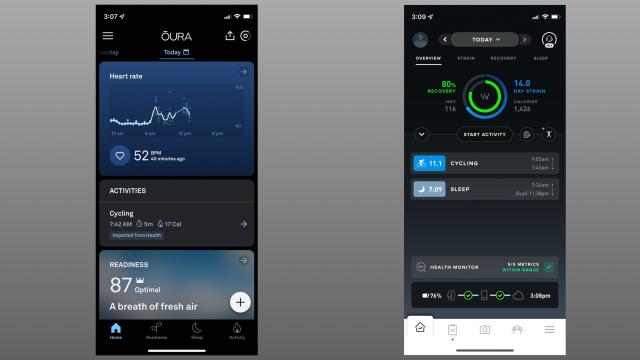The two biggest-name recovery tracking devices, Whoop and Oura, unveiled new hardware recently. There’s now a Whoop 4.0 strap and an Oura gen3 ring. But along with the hardware changes comes a new pricing calculus: Both will require subscriptions. So which is the better deal?
Until recently, the two companies had opposite business models. Oura would sell you a ring for $US299 (A$406) that you could use for free, while Whoop gave you the hardware for free as long as you signed up for at least a six-month subscription (A$44/month, if you pay by the month). Oura’s new ring costs the same as the old one, but there’s now a $US6.99 (A$9.50)/month subscription to go with it.
How much do Whoop and Oura really cost?
Let’s look at a one-year timeframe first. (Both companies have a one-year warranty on their new hardware.)
For Oura, the ring costs $US299 (A$406), and the membership is $US6.99 (A$9.50)/month. After the first year, in theory you’ll have paid $US382.88 (A$520). Right now, though, the company is offering a six-month “free trial” of the subscription, so you’ll only actually pay $US340.94 ($463) that first year.
If you keep the ring for two years, that’s a total of $US681.88 (A$926) with the free trial, or $US765.76 (A$1,040) if they stop offering the free trial.
For Whoop, you’re only paying for the subscription. You can pay by the month as long as you commit to at least six months up front; that’s A$528 for the year, or A$1,056 over two years.
If you know you’ll use the strap for a year, you can pay for an annual membership at A$384 (A$768 for two years). The best monthly rate actually comes from paying for 18 months in one payment of A$432, which drops the price to A$24/month. Two years of Whoop would be A$576 if you buy the 18-month package and then pay by the month for the remaining six months; or if you just keep buying 18-month memberships forever, that’s A$288/year.
What do you get for your money?
First off: Neither gadget is a full-featured smartwatch, and neither has a screen. Oura is a ring, available in gold, silver, shiny black, or matte black, and you wear it on your index or middle finger. Whoop looks like a watch band with a little rectangle of hardware sitting underneath the band. You can buy extra wristbands in a variety of colours if you like, or you can wear it on an armband or in one of the new garments (sports bras, shorts, etc) that have a special pocket to hold the gadget.
Both trackers are surprisingly similar, especially with their recent upgrades. Whoop gained skin temperature, which Oura has already had for a while, and Oura now has one of Whoop’s biggies: daytime heart rate tracking.
If you want a device that can track your heart rate during exercise, Whoop does that already and Oura is planning to add that feature soon.
Both gadgets report on the amount of sleep you get and estimate its quality. Both track resting heart rate and heart rate variability, and both calculate a “recovery” or “readiness” score that they say you can use to predict whether you’ll have a good day in the gym. (I never found these predictions to be particularly accurate, but comparing the scores to your personal experiences is half the fun.)
Both have a battery life that lasts more than a few days, but less than a week. You need to pop the Oura ring onto a charger when it’s running low, and the Whoop has a charging brick that slides over the unit while you’re wearing it, so you never have to take it off. The Oura ring, the Whoop strap, and the Whoop charging brick are all waterproof.
So which is better, the Whoop or the Oura ring?
Oura users are understandably miffed that they’ll now have to pay for hardware and a subscription. But if you know you’ll use your gadget for more than a year, Oura is actually still the better deal. Here’s the breakdown:
- If you just want to try it with the minimum possible commitment, Whoop will run you A$264 (for a six-month membership) and Oura will cost $US299 (A$406) (just the hardware, plus the six-month free trial). Whoop wins here.
- If you commit to a year but no more, the Whoop membership is A$384 for that first year and Oura will run you $US334.94 (A$455) (I’m including the free trial in all calculations). Whoop is still cheaper.
- At two years, the Oura is ahead, at $US406.82 (A$553) compared to A$768 for two years of Whoop.
- At three years, Oura leaves Whoop in the dust: $US478.70 (A$650) for the Oura hardware and subscription, versus A$864 for two 18-month Whoop memberships.
There’s one more factor, which may even the playing field a bit more for short-term users: You can sell an Oura ring when you’re done with it. Currently, gen2 (older) Oura rings are going for $US150 (A$204) to $US180 (A$245) on eBay. The future price of a gen3 ring is impossible to predict, so this aspect is a bit of a gamble, but it’s worth considering.

Leave a Reply
You must be logged in to post a comment.